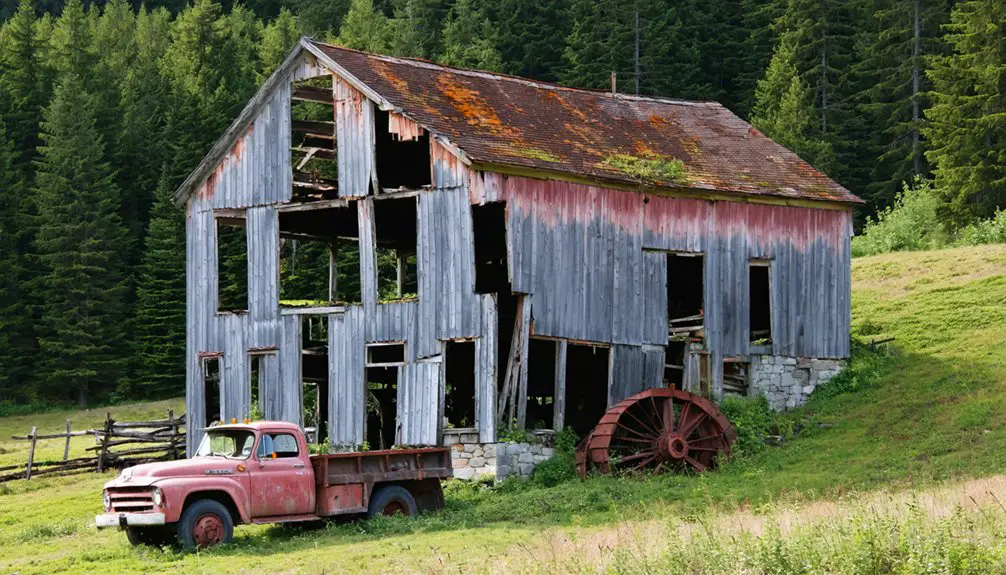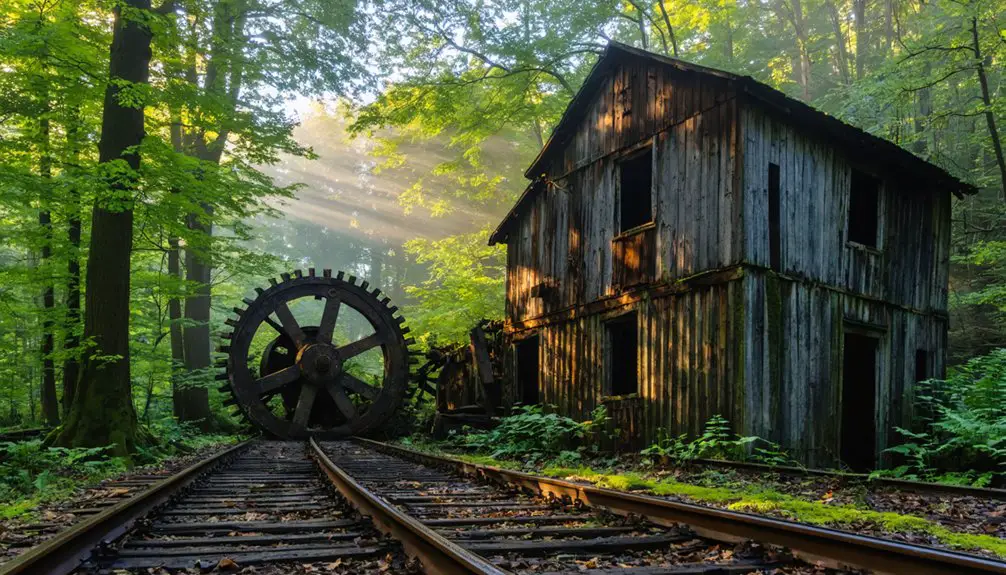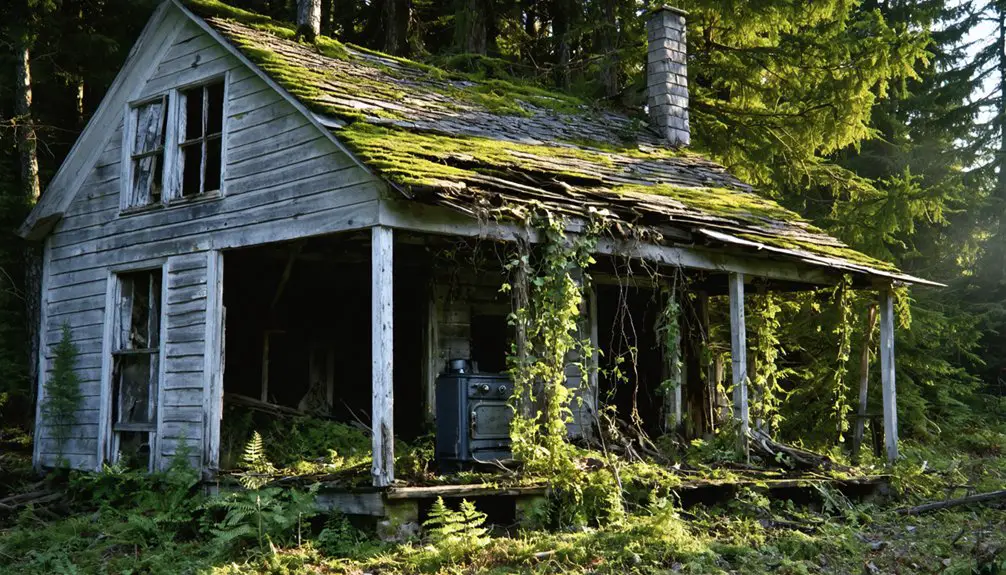You’ll find Dryad, Washington, among Lewis County’s forgotten lumber towns, established in 1916 by the Luedinghaus Brothers. Once home to 3,000 residents, this Northern Pacific Railway stop thrived until the mill’s closure in 1942. Today, about 50 people live near the ghost town’s remnants, where you can spot the old schoolhouse and mill foundations along deteriorating dirt roads. The site’s quiet forests hold countless stories of the Pacific Northwest’s logging heyday.
Key Takeaways
- Dryad was established in 1916 as a lumber town in Lewis County, Washington, thriving until its sawmill’s closure in 1942.
- The town’s population dropped from hundreds to approximately 50 residents after the mill closure, transforming it into a ghost town.
- The abandoned schoolhouse remains as the main visible structure, while nature has reclaimed most other buildings and infrastructure.
- Located along the former Northern Pacific Railway, Dryad was a company town with 100 company-built houses and a central store.
- Visitors can access the ghost town via dirt roads, with local preservation efforts maintaining interpretive signage and historical documentation.
The Birth of a Lumber Town
In 1916, Dryad emerged as a bustling lumber town in Lewis County, Washington, when the Luedinghaus Brothers established their sawmill along the Northern Pacific Railway‘s Chehalis-South Bend branch.
You’ll find that the town wasn’t always at this location – it moved two miles north from its original site at Salal to accommodate the new mill operations.
The railway representatives named the town after wood nymphs from Greek mythology, celebrating the vast forests that surrounded the area.
Advanced logging techniques, including steam donkeys and spur railroads, replaced traditional oxen teams, dramatically increasing timber harvesting efficiency.
The rise of steam-powered logging revolutionized timber harvesting, as mechanical innovation pushed aside the plodding oxen teams of yesteryear.
These innovations, while profitable, left their mark on the landscape. By the 1940s, the environmental impact was clear: the surrounding hills bore deep scars, and large stands of dead trees served as silent testimony to the rapid deforestation.
The town maintained three rotating crews of loggers to ensure continuous operations throughout the year.
Just 18 miles east, the town of Doty Lumber & Shingle operated a competing mill until its closure in 1929.
From Salal to Dryad: Origins of the Name
The transformation from Salal to Dryad marked a pivotal shift in the town’s identity around 1890.
When you relocated just two miles north to accommodate the Leudinghaus Brothers’ new sawmill, you’d find the Northern Pacific Railway exercising its naming authority over the settlement.
William C. Albee, the railway’s South Bend superintendent, chose “Dryad” for its mythological significance – referring to the tree-dwelling nymphs of Greek lore.
While these spirits traditionally inhabited oaks, Albee figured they’d adapt nicely to the region’s towering firs and cedars. Like their mythological counterparts, these nymphs were known for their role as forest protectors.
The name perfectly captured the community identity, reflecting both your timber-based economy and the majestic forests surrounding you.
It’s a reflection of how railway officials often wove classical imagery into the fabric of Washington’s frontier settlements.
By 1941, the once-pristine landscape had transformed into a vista of silver-gray snags and deforested hillsides.
Life in the Company Town
Life under the lumber company’s oversight shaped every aspect of Dryad’s daily existence.
You’d find yourself living in one of about 100 company-built houses, shopping at the company store, and working alongside 300 other men in physically demanding logging and milling operations.
While the town offered essential services like a post office and telegraph, you couldn’t escape the company’s control over your housing and amenities.
Community interactions centered around the mill, company store, and Baptist church, where you’d gather with fellow residents.
The railroad brought crucial connections to the outside world, with two passenger trains daily offering a glimpse beyond company control.
Despite the restrictions of company town life, you’d experience a closely-knit community, though your freedoms remained limited by management’s oversight.
The Railroad’s Vital Role
Built initially by the Yakima and Pacific Coast Railroad in 1890, Dryad’s essential rail connection formed part of an ambitious 19-mile stretch from Chehalis that would eventually reach South Bend’s port.
The railroad’s significance to Dryad’s development can’t be overstated – it literally shaped the town’s location when the Leudinghaus Brothers positioned their sawmill near the tracks. The line became one of the best-paying branches in the Northern Pacific system.
The transportation impact transformed the region’s logging capabilities in four key ways:
- Enabled efficient movement of heavy timber loads
- Connected 29 communities with twice-daily passenger service
- Provided essential freight transport for sawmills
- Attracted lumber company investment with luxury parlor cars
Leudinghaus Sawmill: Heart of the Community
Situated in western Lewis County, Dryad’s economic and social fabric centered around the Leudinghaus Brothers’ sawmill from 1902 to 1930. The mill’s sawmill technology, powered by steam and supported by logging railroads, transformed raw timber into valuable lumber while providing jobs for local families.
The town was relocated from its original site known as Salal, two miles south, to accommodate the construction of the sawmill. You’ll find evidence of community resilience in how the town grew around the mill, with worker housing, a company store, and social gathering spots emerging nearby.
The Northern Pacific Railway‘s presence helped connect Dryad to larger markets, while logging roads crisscrossed the surrounding forests. Despite challenges like flooding and the harsh realities of high-speed logging methods, the mill sustained Dryad’s workforce and drove regional development until the Great Depression.
The Leudinghaus operation left an indelible mark on the landscape and local culture.
Peak Years and Population Boom
You’ll find Dryad’s rapid expansion mirrored Lewis County’s dramatic population surge from 2,600 in 1880 to over 32,000 by 1910, as the Leudinghaus sawmill operations drew workers to the area.
Like many small towns facing eventual decline, such as El Dorado, Oklahoma where abandoned homes abound, Dryad’s initial growth proved unsustainable long-term.
The Northern Pacific Railway‘s presence made Dryad an attractive destination, connecting timber products to broader markets while bringing in new settlers and laborers.
The town’s prosperity peaked in the early 1900s when the combination of rail access and lumber industry jobs created ideal conditions for population growth.
A dedicated disambiguation page helped researchers and historians distinguish between various Lewis Counties when studying the region’s development patterns.
Sawmill Drives Population Growth
The Leudinghaus Brothers’ sawmill sparked a dramatic population surge in Dryad during the late 19th and early 20th centuries, transforming the small settlement into a bustling timber town. Similar to the Yacolt Burn salvage operations that created economic opportunities in other Washington towns.
As sawmill technology advanced, you’d find both skilled and unskilled workers flocking to the area, driving community dynamics that shaped Dryad’s identity.
The town’s growth mirrored Lewis County’s explosive expansion, where you could see the population soar from 2,600 to 41,393 between 1880 and 1940.
The sawmill’s presence created:
- Primary employment opportunities in lumber processing
- Secondary economic growth through local shops and services
- Development of essential infrastructure and schools
- A stable community foundation supporting working families
This industrial boom reshaped Dryad’s landscape, turning a modest settlement into a thriving logging community.
Rail Expansion Attracts Workers
Following completion of the Northern Pacific Railroad’s main line to Tacoma in 1887, Dryad experienced unprecedented growth as rail development transformed the region’s transportation landscape.
You’d have witnessed the railroad benefits firsthand as the Yakima and Pacific Coast Railroad carved its path through the Willapa Hills, connecting Dryad to both Chehalis and South Bend by 1892.
The railway’s arrival sparked significant workforce migration, with workers flocking to emerging lumber towns along the line. Like many towns that relied on railroad communities, Dryad’s existence centered around serving the railways with essential supplies and services.
You could’ve hopped aboard one of Northern Pacific’s twice-daily passenger trains that served 29 communities, complete with parlor cars for lumber company owners.
The rail connection didn’t just move people – it revolutionized timber transport and opened new markets, making Dryad an essential hub in the region’s booming lumber economy.
Economic Downturn and Mill Closure

As Dryad’s timber resources dwindled during the Great Depression, you’d have witnessed the rapid exodus of mill workers and their families from the once-bustling company town.
You’d have seen scores of company-owned houses standing empty after the 1942 mill closure, though some workers managed to purchase their homes outright.
The displaced workforce scattered to nearby lumber communities or urban centers, marking the end of Dryad’s industrial era and its transformation into what you’d now consider a ghost town.
Job Losses Mount Rapidly
When Dryad’s sawmill closed its doors in the early 1940s, the town’s economic foundation crumbled almost overnight.
You’d have witnessed hundreds of mill workers and support staff suddenly without income, devastating the local job market and shattering the town’s economic resilience.
The impact spread far beyond direct mill jobs, as:
- Logging crews lost their contracts and had to seek work elsewhere
- Transport workers saw railway shipping demands evaporate
- Maintenance personnel and equipment operators became redundant
- Local merchants lost their primary customer base
If you’d been there, you’d have seen families packing up and leaving town, seeking opportunities in other lumber communities.
The exodus hit minority workers particularly hard, with Japanese-American employees facing the double blow of mill closure and wartime internment.
Empty Company Houses Remain
Dozens of company houses still dot Dryad’s landscape, standing as silent witnesses to the town’s economic collapse.
You’ll find these abandoned architecture relics exactly as the mill workers left them – windows boarded up, paint peeling, and vegetation slowly reclaiming the yards.
These early 20th-century structures, once maintained by timber company funds, now reflect the stark reality of community decline.
Without the mill’s economic backbone, you’ll see how infrastructure crumbled – unpaved roads lead to empty homes where families once thrived.
The houses remain largely untouched since their abandonment, serving as a time capsule of Washington’s timber industry heritage.
Unlike other restored ghost towns in the state, Dryad’s company houses continue their slow decay, marking the end of an era in Pacific Northwest logging history.
Workers Seek New Communities
Once the mill shuttered its doors, Dryad’s workforce faced devastating economic losses that rippled throughout Lewis County. You’d see worker migration intensify as families sought employment elsewhere, weakening the community’s resilience.
The stark reality was that displaced workers couldn’t find comparable local jobs, forcing difficult decisions about relocation.
The impact on workers included:
- Loss of over $46 million in employee compensation across the region
- Declining property values made it harder to sell homes and move
- Limited job opportunities within commuting distance
- Challenges affording retraining for new industries
Without the mill’s economic foundation, you’d watch as former employees scattered to larger cities or mill towns still operating.
The exodus created a domino effect, reducing school enrollment and shrinking the tax base needed for essential services.
Legacy of the Logging Era

As steam-powered machinery revolutionized Washington’s logging industry in the late 19th century, Dryad emerged as a quintessential timber town shaped by the era’s rapid industrialization.
You can still see the logging impacts etched into the landscape today – by 1941, the surrounding hills had become scarred wastelands dotted with silver-gray snags and forest wreckage.
The ecological consequences of this intensive logging transformed the region. Where virgin forests once stood, clear-cut lands stretched across the horizon, with minimal reforestation efforts to restore them.
Once-pristine forests vanished beneath the logger’s saw, leaving barren hills yearning for the touch of new growth.
The legacy lives on in altered fire regimes and changed landscapes along the Chehalis-South Bend railway corridor. Like many boom towns of its time, Dryad’s fate was sealed when the timber played out, leaving behind a ghost town as evidence of an unsustainable era of resource extraction.
What Remains Today
You’ll find few remnants of Dryad’s once-bustling logging community, as nature has reclaimed most structures and the forest has overtaken former building sites.
The town’s location remains accessible via deteriorating dirt roads, though you’ll need a four-wheel drive vehicle to navigate the challenging terrain in most weather conditions.
While no permanent residents remain in Dryad today, occasional visitors explore the area to photograph what’s left of this memorial to Washington’s logging heritage.
Current Physical Structures
Today, the ghost town of Dryad stands largely reclaimed by nature, with only sparse remnants of its former existence still visible.
You’ll find an old schoolhouse, now abandoned and deteriorating, serving as the most prominent reminder of the town’s past. As you explore the site, you’ll notice how natural reclamation has transformed the landscape, with vegetation overtaking former streets and building plots.
The site’s remaining physical elements include:
- Scattered wooden building foundations, mostly hidden beneath undergrowth
- Partial ruins and structural remnants from the logging era
- Collapsed roofs and weathered timber frames
- The deteriorating schoolhouse structure, though unsafe to enter
No inhabited buildings remain, and most original structures have either been removed or succumbed to decades of exposure to Pacific Northwest weather conditions.
Local Road Access
Reaching Dryad’s ghost town requires careful navigation through a network of connecting roads.
You’ll need to start on SR-2 near Stevens Pass, then turn north onto Tye Road where you’ll spot a small sign marking the ghost town access. From there, you’ll traverse 2.5 miles of rough terrain to reach the site.
Be aware of key road challenges: the Old Cascade Highway is restricted beyond the Cascade Tunnel West Portal, and signage can be tricky to spot.
Navigation tips: bring offline maps due to spotty cell coverage, and consider a high-clearance vehicle for the unpaved sections.
Once you arrive, you’ll find adequate parking and basic facilities including vault toilets. The Iron Goat Trail intersection near the final turnoff serves as a helpful landmark.
Population and Activity
While Dryad once bustled with nearly 500 residents during its lumber-milling heyday in the 1930s, the town has dwindled to roughly 50 inhabitants in modern times.
The demographic shifts following the Leudinghaus Sawmill’s closure in 1930 transformed this once-thriving logging community into a near ghost town.
Today’s community dynamics reflect the town’s dramatic decline:
- No active commercial or industrial operations remain
- Most original structures stand abandoned or in poor condition
- Limited community services or gathering places exist
- The population primarily consists of rural residents and retirees
You’ll find few traces of Dryad’s former liveliness, as the surrounding logged-out hills and quiet streets tell the story of a Pacific Northwest boom town that couldn’t survive its resource depletion.
Preserving Dryad’s History
Through generations of dedicated local historians and community members, the preservation of Dryad’s rich timber heritage remains an ongoing challenge.
You’ll find few original structures standing, as the town’s physical remnants mirror the fate of many Western Washington ghost towns. Local preservation strategies focus on protecting foundational ruins, maintaining interpretive signage, and documenting the area’s historical significance through partnerships with regional historical societies.
If you’re interested in exploring Dryad’s past, you can access oral histories and photographic archives that tell the story of this former logging community.
Volunteer-led cleanups and interpretive tours help protect what’s left while educating visitors about the town’s lumber industry roots. The nearby cemeteries and pioneer sites offer tangible connections to early settlers, though intensive logging has left lasting scars on the surrounding landscape.
Frequently Asked Questions
Are There Any Historical Buildings Still Standing in Dryad Today?
You won’t find any standing historical buildings in Dryad today, as the architectural features and historical significance of this former timber town have been lost to time and nature.
What Natural Disasters or Accidents Occurred in Dryad During Its Operation?
You won’t find documented flood events or mill accidents in historical records from Dryad’s operational period. The only significant damage reported was environmental destruction caused by aggressive logging practices.
Where Did Most of Dryad’s Former Residents Relocate After the Mill Closure?
You’ll find most former Dryad residents relocated to nearby Snohomish and Skagit county towns like Darrington and Arlington, while others sought economic opportunities in larger cities like Everett and Seattle during the community migration.
Did Any Famous People or Notable Figures Come From Dryad?
While famous residents didn’t emerge from this lumber town, you won’t find notable landmarks either – Dryad’s legacy lies in its industrial role rather than producing celebrities or cultural icons.
What Indigenous Tribes Originally Inhabited the Area Before Dryad’s Establishment?
You’ll find the Coast Salish peoples, particularly the Chehalis Tribe, were the original stewards of this cultural heritage. The Cowlitz Tribe’s tribal history also extends into these ancestral territories.
References
- https://stateofwatourism.com/ghost-towns-of-washington-state/
- https://everydayspokane.com/ghost-towns-in-washington-state/
- https://www.historylink.org/File/23208
- https://jtenlen.drizzlehosting.com/walewis/townsal.html
- https://parks.wa.gov/about/news-center/field-guide-blog/willapa-hills-state-park-trail-history
- https://www.riverbendpreserve.com/stories/history-of-doty
- https://revisitwa.org/waypoint/dryad/
- https://www.newspapers.com/article/37740/dryad_wa_history_thedaily_chronicle/
- https://kids.kiddle.co/Dryad
- https://ir.library.oregonstate.edu/dspace/bitstream/1957/9548/1/Ori_Of_Was_Geo_Nam.pdf



